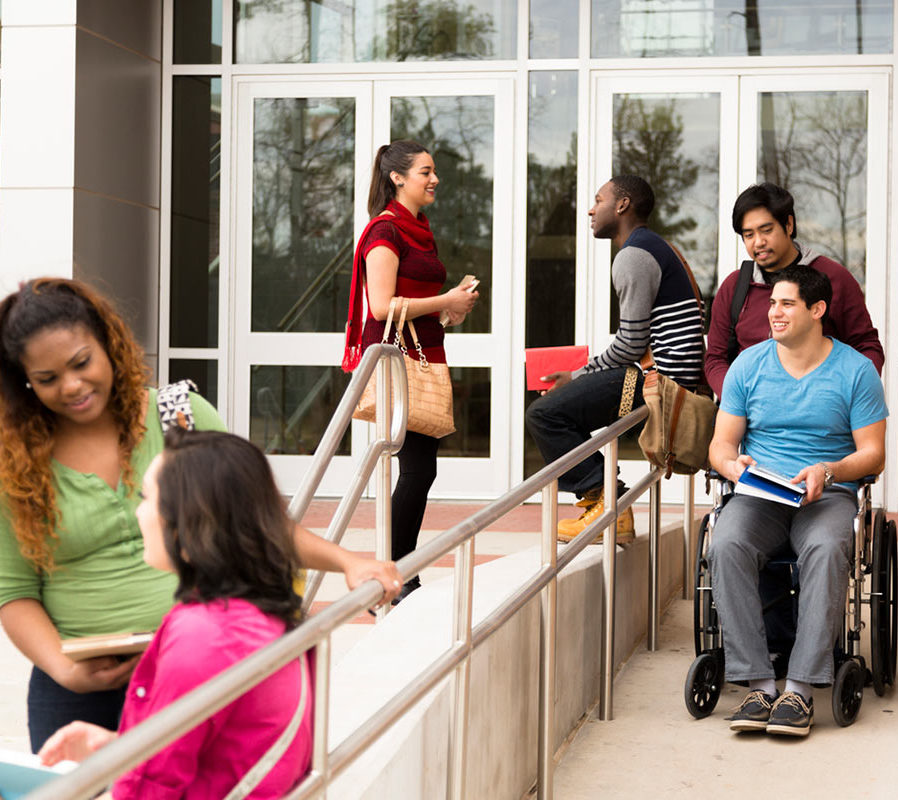It’s Ethical
Simply put, web accessibility is the right thing to do. Websites should be fundamentally designed to work for everyone. Building an accessible website removes barriers to your web visitors in the same way that ramps and elevators do in physical spaces.
According to the W3C (n.d), the UN Convention on the Rights of Persons with Disabilities recognizes access to information and communications technologies, including the web, as a basic human right.
It helps everyone.
It’s important to remember that following accessibility guidelines helps make websites that are accessible to people with diverse abilities and situations. While following WCAG assists those with auditory, cognitive, neurological, physical, speech, and visual disabilities, it also helps anyone…
- who is visiting from a device with a smaller screen.
- with age-related impairments, like reduced vision and dexterity.
- with a slower internet connection.
- with a temporary impairment, like a broken arm or lost glasses.
- with a situational impairment, like bright sunlight, a noisy room, or limited time.
The power of the Web is in its universality.
Access by everyone regardless of disability is an essential aspect.
— Tim Berners-Lee, W3C Director and inventor of the World Wide Web
With the COVID pandemic, equitable access to the web has become critical. We have come to depend on the web for so much: working; education; groceries; appointments; banking; fitness; mental health; and socializing. According to the Canadian Internet Use Survey (Bilodeau, Kelher & Minnema, 2021), 75% of Canadians 15 years of age and older engaged in various internet-related activities more often since the onset of the pandemic, and almost half (48%) of Canadians reported performing at least one of various internet-related activities for the first time during the pandemic.
Simply put, adapting your website to be accessible makes it easier for everyone to find and access information online.
It’s Inclusive
Imagine a library so vast that it encompasses 2.39 billion books — the current number of pages on the World Wide Web —but its doors are locked to 1 billion people. By not adapting web and digital content to be accessible, we could be excluding the 15% of the world’s population who experience some form of disability. These locked doors are the current reality of the 6 million Canadians aged 15 and over (22% of the population) who identify as having a disability.
Accessible websites open the door to allowing contributions and interactions with wider communities which might not otherwise be within reach.
Treating people differently — that is, restricting their accessible access to digital content because they have a disability — is something called digital ableism. Creating accessible web content may cost us time and money, but “when we de-prioritize accessibility in tech we are telling people that their basic human needs are not profitable enough to matter.” (Lall, 2021). Please explore the Accessible Foundations training series on this website to learn more about ableism.
It’s important to remember that while others’ daily experience might be different than yours, they are a person, and are deserving of equal access to the web.
Exploring Adaptive Technologies
Imagine trying to interact with a website without a mouse. Now, imagine you can’t see the website either. What would you do? Visit The Big Hack to learn how blind user Holly Tuke explores websites, and the five most annoying things she faces as a blind person every day.
By using adaptive technologies, visitors can efficiently interact with your website — if it’s accessible. Some examples of adaptive technologies and techniques are included below.
| Adaptive Device or Technique | Disability |
|---|---|
| Screen readers that allow users listen to the content of a webpage. | Blindness |
| Software that reads content aloud and may also highlight words and phrases. | Dyslexia |
| Screen magnification for zooming in; the ability to change the contrast or colour of webpage elements. | Visual Impairment |
| Audio captioning and transcriptions. | Deaf or Hard of Hearing |
| Head pointers; mouth sticks; motion and eye tracking; speech input software. | Mobility |
Learn more about Types of Disabilities and Barriers from Ryerson University.
Experience the Web with a Simulated Disability
It’s Best Practice
Website accessibility guidelines overlap with web development best practices. By following WCAG, you improve the user experience for all website visitors. Your website will be easier to browse, and in general, will load faster than a website which does not follow best practices. According to the W3C (n.d), case studies show that accessible websites have better search results, reduced maintenance costs, and increased audience reach, among other benefits.
Both WCAG and web practices for coding and SEO (search engine optimization) emphasize:
- A clear site structure, including logical navigation, and the use of breadcrumbs and sitemaps.
- Appropriate page titles and meta information (the website title that appears in Google results).
- Page titles and subtitles that make sense and properly describe the content following them.
- Headings that follow the correct hierarchy.
- Underlying code which is semantically correct.
- Alternative text on images and other visual content.
- Link text which sets user expectations without context.
- An appropriate reading level for your content, with a focus on short, simple words and brief paragraphs.
Explore our Web Accessibility Articles
Explore the articles in our Web Accessibility training series to learn more about how to create accessible web content.
Access the Web Accessibility Training SeriesIt’s a Legal Obligation
In the Province of Ontario, Canada, the Accessibility with Ontarians with Disabilities Act (AODA) states that as of January 1, 2021, all public websites who meet specific criteria must meet WCAG 2.0. Specific requirements and reporting deadlines depend on the type and size of your business or organization. Enforcement of the AODA includes inspections, audits, and monetary fines. Learn more about the AODA.
Other provinces in Canada have also passed their own acts, including Manitoba with the Accessibility for Manitobans Act (AMA) and Nova Scotia’s Access by Design 2030.
Accessibility Policies Around the World
Legal obligations related to accessibility vary throughout the world. We encourage you to research web accessibility for your region. Visit 3PlayMedia’s Countries that Have Adopted WCAG Standards website for a list and visual map of all of the countries in the world who have committed to meet WCAG.



